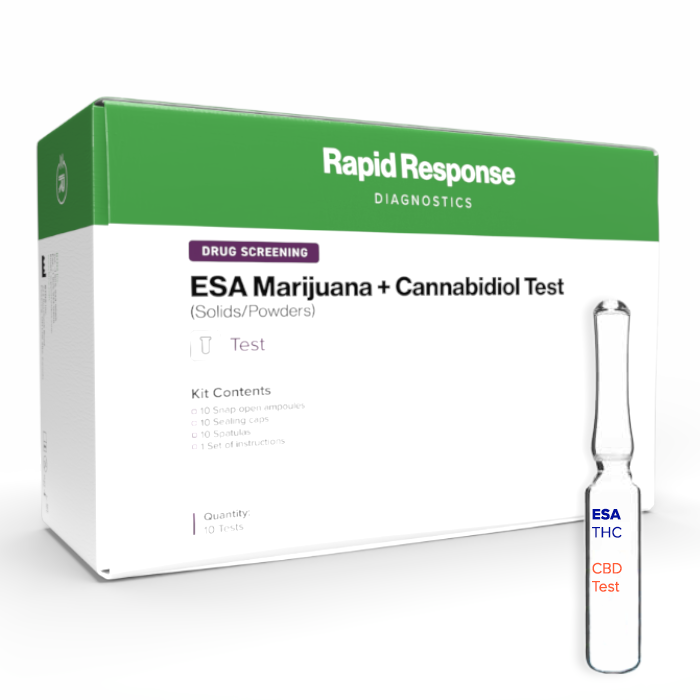

A preliminary test for detecting marijuana and cannabidiol. The test can be used to assist police and customs officials working in the field of drug control.
Note: The colour change is usually recognisable after 3 minutes. Depending on the test substance, the evaluation of the colour change may only be possible after a reaction time of approximately 10 to 15 minutes.
- 10 Snap-open ampoules
- 10 Sealing caps
- 10 Spatulas
- 1 Set of instructions
A preliminary test for detecting marijuana and cannabidiol. The test can be used to assist police and customs officials working in the field of drug control.
Note: The colour change is usually recognisable after 3 minutes. Depending on the test substance, the evaluation of the colour change may only be possible after a reaction time of approximately 10 to 15 minutes.
- Tap the unopened ampoule several times against a hard surface, such as a tabletop. By doing this, particles which may be stuck to the inside of the ampoule wall will fall to the bottom.
- Carefully remove the polyethylene sealing. Ensure that the powdery reagent contained in the cap does not fall out.
- Open the ampoule as follows: Hold the ampoule firmly at the bottom with one hand. Take the ampoule tip between the index finger and thumb of the other hand and snap it off at the predetermined breaking point by lateral pressure.
- Transfer a small quantity of the sample into the ampoule, by using the enclosed spatula. Whilst transferring the sample, make sure to hold the ampoule in an upright position so that the substance falls to the bottom of the ampoule.
- Allow the sample and the reagents to mix. This can be done by tapping with a finger or by repeated stirring with the spatula.
- After completing the test, the ampoule must be sealed.
Please refer to the instructions for use for more details.
- Color change will begin within 1 minute. Result interpretation should take place within a maximum of 3 minutes.
- An overview of the expected color changes can be found in the table at the end of the package insert. The color comparisons for selected substances can be consulted at the beginning of the package insert, as well as in the referenced literature.
- The presence of ephedrine, amphetamine or methamphetamine in the sample will cause a red-orange colour to occur.
- The presence of THC (Marijuana) in the sample causes a green colour change.
- The presence of CBD (Cannabidiol) leads to a red to violet colour change.
Please refer to the instructions for use for more details.
- S. H. John, A. A. Wist, A. R. Najam, J Forensic Sci, 1979, 24, 631-649
- M. D. Osselton, B. Widdop, A. C. Moffat, "Clarke’s Analysis of Drugs and Poisons”, Pharmaceutical Press, 2011 (4th Ed.)
- U.S. Department of Justice, “Color Test Reagents/Kits for Preliminary Identification of Drugs of Abuse”, 2000
- Please note that certain products may only be available in specific regions; kindly consult with a sales representative for further information regarding product availability.
- The information provided on this website is for educational purposes only and should not be construed as medical advice. Always consult with a qualified healthcare professional regarding any medical concerns or conditions.
- Our products are intended for use as specified in the product documentation. It is important to carefully read and follow all instructions provided with the product.
